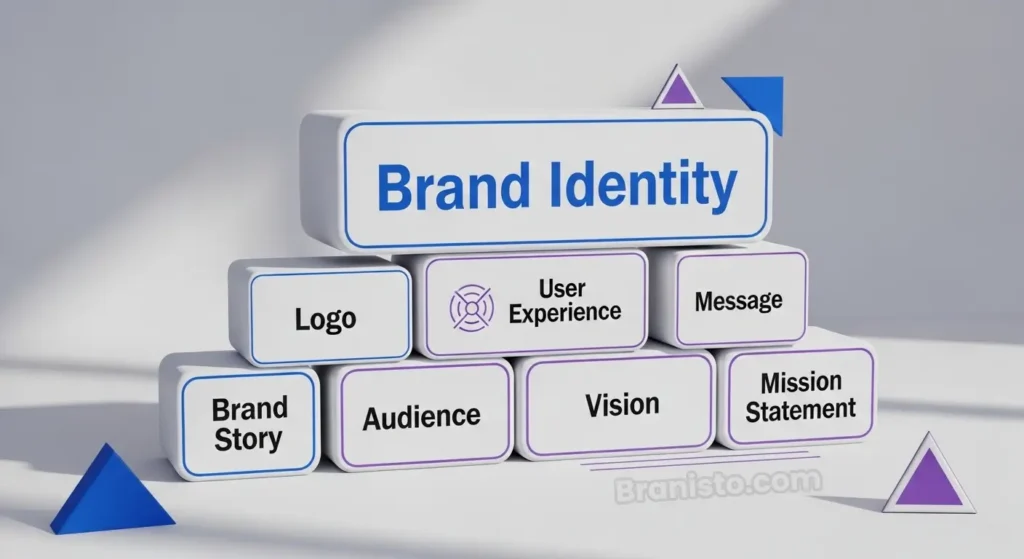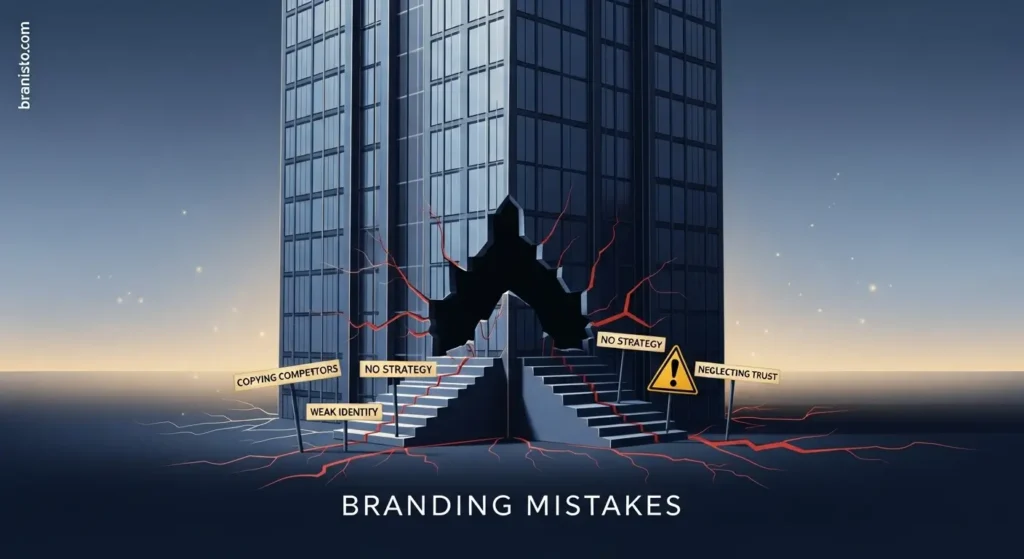Ready to Build a Brand People Trust? Here’s What You’ll Learn
Branding is a big topic. It includes everything from logos and colors to messaging, customer experience, and the emotions people feel when they think of your business.
In this article, you’ll get a quick and clear introduction to what branding really means—just enough to understand the essentials. But more importantly, we’ll focus on why branding is so important for startups, and how it can help you build a business that people trust, love, and remember.
Whether you’ve just launched or are still figuring things out, this guide will walk you through branding in a way that’s easy to understand, practical to apply, and inspiring to follow.
By the end of this article, you’ll learn:
• What a brand is (and what it isn’t)
• Why Branding Is Essential and Its Importance for Startup Growth, Trust, and Visibility
• How to create a brand that looks, sounds, and feels right
• Simple steps to start building your brand with confidence
• Common branding mistakes startups make and how to avoid them
Table of Content
- Ready to Build a Brand People Trust? Here's What You'll Learn
- Table of Content
- Video Overview: Why Branding is Essential, It's Importance
- Podcast: Listen the Article
- What is a Brand: Understanding What a Brand Really Means
- Why Branding Is Essential and Important for Startups
- Key Elements of a Strong Startup Brand: Essential Building Blocks for Lasting Success
- How Branding Impacts Startup Growth
- Practical Steps to Build a Startup Brand
- Common Branding Mistakes Startups Should Avoid
- Conclusion: Branding as the Cornerstone of Startup Success
- Startup Branding FAQs
- What exactly is a brand, and how does it differ from a business?
- Why is branding particularly crucial for startups?
- What are the key elements of a strong startup brand?
- How does branding contribute to growth and financial success?
- What role does consistency play in branding?
- Besides attracting customers, how else does branding help?
- What practical steps can startups take to build their brand?
- What branding mistakes should startups avoid?
Video Overview: Why Branding is Essential, It’s Importance

Imagine your startup’s brand as its personality and promise in one package. It’s not just a logo or a catchy name – it’s the entire image and experience your company presents to the world. In simple terms, a brand includes all the elements (name, design, messaging, values) that make your business recognizable and distinct. As Investopedia explains, “A brand is a product or a business with a distinct identity among consumers,” created through design, packaging and advertising. A successful brand adds enormous value to a company and gives it a competitive edge. In short, your brand is like your business’s reputation and visual identity rolled into one.
Podcast: Listen the Article
What is a Brand: Understanding What a Brand Really Means
A brand is a combination of tangible elements (like your name, logo, design, and website) and intangible elements (such as your reputation, values, and how people feel about you). After reviewing multiple expert definitions, we can conclude:
“A brand is the identity of a business, shaped in the minds of its stakeholders.”
Stakeholders include anyone connected to your business in some way. It could be customers, employees, investors, partners, or even the community. Each of these groups forms perceptions based on their interactions and experience with your company.
ZenBusiness highlights this well: a brand ultimately “lives in the consumer’s mind as a public perception – it’s intangible.” In practice, this means your startup’s brand is not just a label or a logo. It’s the feelings, expectations, and trust signals people carry with them whenever they think about your business.
Brand vs Business: Understanding the Key Differences
It helps to distinguish brand from business. Your business is the actual company: it makes products or delivers services, handles operations, and generates revenue. In contrast, your brand is the identity and personality of that company. A business can exist without a strong brand, but a brand cannot exist without a business behind it. One guide puts it well: a business is the engine driving revenue, while the brand is the heart that connects emotionally with customers. In other words, the business focuses on operations and profits, whereas the brand encompasses your identity, values, and reputation. A strong brand tells customers who you are and why you matter, even as your business grows.
Table (comparison):
| Aspect | Business | Brand |
|---|---|---|
| Core Meaning | The company that produces products or delivers services | The identity and personality of the company |
| Purpose | Drives revenue, manages operations | Builds trust, shapes perception, and connects emotionally |
| Focus | Operations, profits, and efficiency | Identity, values, reputation, and customer experience |
| Dependency | Can exist without a strong brand | Cannot exist without a business behind it |
Branding Beyond the Logo: Identity, Values & Experience
Many people think a brand is just a logo or product name. In reality, a logo is only one part of the bigger picture. Brand identity includes your logo, color palette, typography, tone, and overall design aesthetic. These visual elements create a recognizable image that customers remember. However, your brand also extends to voice and messaging: the tone you use in advertising, social media, and customer interactions. For example, Qualtrics notes that brand perception is shaped by customer experiences, reviews, and word of mouth (the recommendations people share with friends, family, or colleagues). In short, a brand is the complete experience and message you deliver, not just the graphic on your website. All these elements (visual style, tone, and values) must work together to create the image you want the public to see.

Why Branding Is Essential and Important for Startups
Good branding is critical for startups. Even with a great product, a startup still needs a clear brand to gain visibility and attract customers. Branding builds trust and credibility: research shows that about 4 out of 5 (80%) consumers need to trust a brand before buying from it. When your branding looks professional and consistent, it signals quality and reliability. This credibility is especially important for new businesses trying to win customers and investors. A polished brand presence can make your startup appear more established and trustworthy, which greatly supports early growth.
Building Trust and Credibility
Research proves this: up to 90% of new startups fail if people don’t trust or understand them. Studies show 65% of business comes from repeat
customers, and 67% of buyers only return if they trust the brand. Trust and clarity are not optional. They are survival tools.
Trust is the foundation of any customer relationship. By branding effectively, you show that your startup is serious and reliable. Consistency in your visual identity and messaging demonstrates attention to detail, which reassures customers. In fact, 81% of consumers say they need to trust a brand before considering a purchase. When customers trust your brand, they are more likely to remain loyal and become repeat buyers. In practice, every well-designed logo, clear tagline, and on-brand customer interaction adds up, making your startup more credible in the eyes of both customers and investors.
Standing Out in a Competitive Market
Startups compete with established companies, and branding is what makes you stand out. A clear identity and unique value help customers remember and choose you. Research shows 77% of consumers buy from brands that share their values, and 59% prefer brands they recognize. By positioning your startup clearly, you cut through the noise, making your brand a distinctive story that attracts customers, investors, and partners.

Key Elements of a Strong Startup Brand: Essential Building Blocks for Lasting Success
A strong brand has several core components that work together. Brand identity is the visual and emotional face of your business. Brand values are the principles you stand for. Brand messaging and voice are how you communicate or share those values with your audience. Let’s break each one down:
Visual Identity: Logo, Colors, and Design Elements
People remember what they see. Visual branding makes your startup instantly recognizable. It includes your logo, color scheme, typography, and graphic style: each reflecting your company’s personality. Tech startups often use blue for trust, while creative startups may use vibrant colors to show energy and innovation.
Consistency is crucial: use the same logo, colors, and fonts across your website, packaging, and social media to strengthen brand recall. Research shows color can boost recognition by 80%, and blue appears in 40% of Fortune 500 logos because it builds trust. Many companies have invested heavily in logo redesigns to maintain a strong visual identity: the cybersecurity firm Symantec spent an estimated $1.28 billion, British Petroleum (BP) $211 million, the BBC $1.8 million, and PepsiCo $1 million. These examples show how critical visual branding is for credibility and brand recognition.
Key Elements:
- Logo: Simple, relevant, and memorable.
- Color Scheme: 2–3 colors that evoke the right emotions consistently.
- Typography & Imagery: Fonts and visuals that match your brand’s mood and feel cohesive.
- Imagery/Photography Style: Consistent photos or illustrations that align with your startup’s mood and audience.
- Brand Guideline (Style Guide): Document how your logo, colors, fonts, imagery, and tone should be used across all platforms to ensure consistency.
Together, these elements create a professional, credible, and memorable brand identity.
Crafting Brand Story and Mission
Every startup has a story. Your brand mission explains why your business exists beyond making money, the higher purpose or problem you solve. For example, Tesla’s mission, “to accelerate the world’s transition to sustainable energy,” gives people a reason to care.
Harvard research shows brand value grows when brands create meaning. Share why you started, who you serve, and your dream. 94% of marketers say personalized content boosts brand building.
A clear brand purpose adds meaning and impact, and studies show purpose-driven brands outperform others, sometimes beating the stock market by 120%.
Your brand story brings this purpose to life. Include your founder’s journey, your vision for customers, or key milestones. A well-told story creates an emotional connection, makes your startup memorable, and encourages customers to join your mission.
Brand Voice and Communication Style
Your brand voice is your startup’s personality in words. It shows how you “talk” to your audience: are you friendly, professional, inspiring, or playful? Research shows that 95% of buying decisions are subconscious, meaning your words matter as much as your visuals.
For example, a playful toy startup might use a light-hearted, fun voice, while a fintech startup might choose clear and concise language to convey trust. Qualtrics defines brand voice as “the unique personality that your brand presents to the world,” and it should stay consistent across all channels.
Along with voice, your tone of voice adjusts the emotional variation depending on the situation: think of it like a friend who is usually upbeat (voice) but might be serious during a crisis (tone). By keeping your brand voice consistent and adjusting tone appropriately, customers immediately recognize your communication style. This consistency across your website, emails, social media, and ads reinforces your brand identity and builds trust.
Unique Value Proposition (UVP)
Your UVP clearly explains why customers should choose your startup over competitors. Highlight the problem you solve, the benefit your solution offers, and what makes you unique. A strong UVP helps you stand out in a crowded market and ensures your messaging is focused and memorable.
Target Audience and Customer Personas
Knowing your audience is critical for startup success. Define your ideal customer’s age, interests, challenges, and needs using simple customer personas. Understanding your audience ensures your product, messaging, and marketing resonate with the right people. Studies show 67% of customers only continue buying if they trust the brand.
Here is an example of a Customer Persona:
| Attribute | Details |
|---|---|
| Name | Sara |
| Age | 29 |
| Occupation | Marketing Professional |
| Location | Urban city |
| Interests | Fitness, eco-friendly lifestyle, healthy cooking |
| Challenges / Pain Points | Busy schedule, limited time for meal prep, wants convenient healthy options |
| Goals / Needs | Save time, maintain a healthy lifestyle, support sustainability |
| Preferred Solutions | Weekly meal kit subscription with fresh ingredients and easy recipes |
| Communication Preferences | Email newsletters, social media updates, short informative videos |
| Buying Motivation | Convenience, health benefits, trust in brand |
Building a Strong Social Media Presence on All Platforms
Building a strong social media presence is crucial for startups to reach and engage their audience. Go where your customers already are and use the platforms they interact with most. Share behind-the-scenes content, customer success stories, and helpful tips to create meaningful connections. Branded hashtags are powerful; 64% of consumers use them when posting online, boosting brand awareness. According to Sprout Social, 70% of marketers say increasing brand awareness is their top priority, making social media a key channel for growing visibility, trust, and engagement.
Consistency Across All Channels
Consistency is essential for building recognition and trust. Maintain uniform logos, colors, fonts, messaging, and tone across all touchpoints, including your website, social media, emails, and packaging. Research shows that consistent branding can increase revenue by 23%.
Measurement and Improvement
A strong brand evolves. Use analytics, surveys, and customer feedback to track performance. Measure engagement, repeat customers, website traffic, and Net Promoter Score (NPS) to see what’s working and what needs improvement. Data-driven adjustments keep your brand relevant and growing.

How Branding Impacts Startup Growth
Investing in branding fuels startup growth. Done right, branding builds awareness, strengthens equity, and boosts customer loyalty, all of which drive revenue. Research from the IPA shows that startups focusing on brand-building early achieve 58% higher sales and 55% more profit compared to those relying only on short-term marketing. This proves that branding is not just a feel-good activity; it has a measurable impact on the bottom line.
Brand awareness is critical. Customers are more likely to buy from brands they recognize. According to Nielsen, people are about 80% more likely to choose a familiar brand over an unknown one. This familiarity comes from consistent branding and repeated exposure. For example, Apple’s early focus on consistent branding from product design to advertising helped it become one of the most recognized and trusted tech brands in the world.
Brand equity, the added value a name carries, also increases with strong branding. A well-known brand can often command premium prices because customers trust it. For example, Nike’s strong brand equity allows it to charge higher prices for shoes simply because of the perceived quality, status, and trust associated with its name. Similarly, Tesla’s brand equity lets it sell electric cars at a premium, even when competitors offer cheaper alternatives, thanks to the brand’s reputation for innovation and sustainability.
By building a memorable brand now, startups lay the foundation for long-term growth, higher sales, and increased profitability.
Attracting Investors and Partnerships
A polished brand opens doors to funding and partnerships. Investors are drawn to startups with a clear vision and strong market appeal. When your branding communicates a compelling narrative and professional image, it signals that you have carefully thought through your business strategy. Entrepreneur magazine highlights that a strong brand makes startups more attractive to investors by clearly conveying vision and growth potential. Likewise, other companies are more likely to partner with a brand they recognize and trust. From pitch decks to websites, a confident and cohesive brand presence helps you stand out from other founders and make a lasting impression.
Driving Customer Loyalty and Retention
Strong branding keeps customers coming back. Trustworthy brands build loyalty, and research shows consumers are more than twice as likely to buy, stay loyal, and advocate for brands they trust. When your brand consistently delivers on its promises, customers form an emotional connection and develop repeat purchase habits. Loyal customers naturally become advocates, recommending your brand and reducing future marketing costs. Every positive interaction, from unboxing to customer support, strengthens your brand equity and makes your business more resilient over time.
Branding’s Impact on Employees
A strong brand not only attracts customers but also inspires employees. When your startup clearly communicates its vision, purpose, and values, your team feels proud and connected. Employees who understand and engage with your brand are more productive, committed, and likely to stay long-term. Companies like Google, Microsoft, and Apple excel at internal branding, creating loyalty and attracting top talent. Research from Gallup shows that highly engaged employees drive 147% higher earnings per share, highlighting the tangible impact of a strong brand on workforce performance.
Pricing Power and Profitability
Effective branding boosts pricing power and profitability. When customers trust and value your brand, they see your products or services as premium and are willing to pay more. Companies like Apple, Microsoft, and Google consistently command higher prices because their brands signal quality, innovation, and reliability. Strong branding directly enhances profit margins, increases revenue, and positions your startup for long-term financial growth.
Brand Value as a Business Asset
A well-built brand goes beyond a logo or color scheme; it is a valuable business asset. Strong brand value not only enhances overall company valuation but also strengthens market position and can be sold or licensed. Research from Harvard Business School shows that brands with a clear purpose and strong recognition significantly outperform competitors in market capitalization. For Example, Leading tech companies demonstrate the tangible impact of brand value:
| Company | Brand Value (USD) | Market Capitalization (USD) | Brand Value as % of Market Cap |
|---|---|---|---|
| Apple | $574.5B | $3.61T | 15.9% |
| Microsoft | $461B | $4.0T | 11.5% |
| $413B | $2.3T | 18.0% |
By consistently investing in your brand, your startup gains an intangible asset that grows over time, benefiting both investors and founders. These figures illustrate that a strong brand is not just symbolic; it delivers real, measurable value to the business.

Practical Steps to Build a Startup Brand
Building a brand is a process. Here are practical steps to guide you:
Define Your Purpose and Target Audience
- Clarify Your Mission: Clearly define why your startup exists and the problem you aim to solve. Your brand purpose or mission serves as the foundation for your entire branding strategy. Purpose-driven brands consistently outperform others, so make it clear and compelling.
- Know Your Audience: Identify the specific customers you want to serve. Understanding their needs, values, and pain points allows you to craft a brand message that truly resonates. Trying to appeal to everyone often results in generic branding. Focus on the audience who will genuinely connect with your offering. For example, Nike tailors its branding specifically to athletes.
Create a Cohesive Identity Across Channels
- Consistency is Key: Use your logo, colors, fonts, and messaging consistently across all platforms. From your website to social media to packaging, a unified visual and verbal identity builds recognition and trust. Research shows that companies with consistent branding across all channels often experience significant revenue growth, typically 10–20% higher.
- Develop Brand Guidelines: Create a clear brand style guide that documents your brand elements, including logos, colors, fonts, and tone of voice. Use it as a reference for every new asset, ensuring that team members and vendors maintain a cohesive and professional brand identity.
Leverage Online and Social Media Branding
- Optimize Your Digital Presence: Ensure your website and social media profiles reflect your brand visuals, messaging, and tone. An on-brand website and active social channels boost awareness, credibility, and trust. For example, 89% of marketers report that social media increases their brand’s exposure.
- Produce Value-Driven Content: Share blog posts, videos, or social updates that showcase your expertise and reflect your brand voice. Providing useful, relevant content draws people in, reinforces your brand story, and keeps messaging aligned with your mission and values.
- Engage Your Community: Stay connected with your audience through social media and email marketing. Respond to comments, run campaigns, and encourage user-generated content. Active engagement strengthens your brand reputation and fosters long-term loyalty.

Common Branding Mistakes Startups Should Avoid
Even small missteps can weaken a brand. Keep these pitfalls in mind:
Ignoring Consistency in Branding
If your brand appears differently across platforms, customers can become confused. Inconsistent visuals or messaging signal a lack of professionalism. Consistent branding fosters trust and comfort, while inconsistencies make companies appear disjointed. Always use the same logo, colors, fonts, and tone across every channel. For example, a dark website paired with bright pastel social media visuals can send mixed signals and weaken your brand identity. Maintaining consistency builds trust and makes your brand instantly recognizable.
Copying Competitors Instead of Differentiating
Avoid Copying Competitors: Mimicking a competitor’s look or chasing every design trend can backfire. While staying aware of trends is useful, building your brand entirely around what’s hot makes it forgettable when trends shift. Your startup’s brand should highlight what makes you unique: your story, values, and style. Focus on your unique value proposition instead of copying others. This ensures customers remember your brand rather than confusing it with competitors.
Underestimating Long-Term Brand Strategy
Branding Is an Ongoing Investment: Branding is not a one-time task; it requires continuous effort. A common mistake is rushing a logo or neglecting branding after launch, which can lead to fragmented efforts. Building a strong brand takes time and consistency. Startups that balance brand-building with sales campaigns achieve stronger revenue and profit growth. Think of branding as a foundation built layer by layer. Define your strategy early and refine it as your business grows.

Conclusion: Branding as the Cornerstone of Startup Success
Your startup’s brand is the foundation for growth. By clearly defining your purpose, crafting a consistent visual identity, and communicating with a strong, authentic voice, you create a memorable presence that earns the trust of customers and investors alike. Effective branding transforms an idea into a living, breathing entity that people connect with. Every interaction, from content to customer service, reinforces your promise and builds long-term loyalty.
At Branisto, we believe every startup has the potential to become a strong, recognizable brand with the right approach. Our strategies refine systems, simplify processes, and guide founders step by step. Learn more about our services designed to help startups build a lasting brand. When you’re ready to build a brand that lasts, explore our expert insights at Branisto.com.
Startup Branding FAQs
What exactly is a brand, and how does it differ from a business?
A brand is the identity and personality of a business, including visuals like logos and colors, and intangibles like reputation, values, and emotions. While a business handles operations and profits, the brand connects emotionally with customers and builds trust. A business can run without a strong brand, but a brand cannot exist without a business.
Why is branding particularly crucial for startups?
Branding builds trust, credibility, and differentiation. Research shows 80% of customers must trust a brand before buying, and most startups fail when trust is absent. Consistent branding makes startups look professional and helps them attract customers, investors, and partners. Startups that invest early in branding see stronger sales and profit growth.
What are the key elements of a strong startup brand?
- Visual Identity: Logo, colors, typography, and imagery used consistently.
- Brand Story & Mission: Purpose, values, and the problem solved.
- Brand Voice: Personality in communication, whether professional, friendly, or inspiring.
- Unique Value Proposition (UVP): Why customers should choose you over competitors.
- Target Audience: Knowing customer needs, challenges, and values.
How does branding contribute to growth and financial success?
Strong branding increases awareness, customer loyalty, and revenue. Recognizable brands can charge premium prices and attract investors. Research shows startups that focus on branding achieve higher sales and profitability. A strong brand is also a valuable business asset that strengthens market position.
What role does consistency play in branding?
Consistency builds recognition and trust. Using the same logos, colors, fonts, and tone across all channels prevents confusion and increases professionalism. Studies show consistent branding can boost revenue by up to 23%. Brand guidelines help maintain a cohesive identity.
Besides attracting customers, how else does branding help?
Branding also influences investors, partners, and employees. A polished brand signals strong strategy, attracting funding and partnerships. Internally, a strong brand motivates employees, improves productivity, and attracts top talent.
What practical steps can startups take to build their brand?
- Define Purpose & Audience: Clarify mission and customer needs.
- Create a Cohesive Identity: Use consistent visuals and messaging.
- Leverage Digital Platforms: Build a strong online presence with engaging content.
- Measure & Improve: Use data and feedback to refine branding over time.
What branding mistakes should startups avoid?
- Inconsistency: Confuses customers and weakens trust.
- Copying Competitors: Makes the brand forgettable; focus on uniqueness.
- Neglecting Long-Term Strategy: Branding is ongoing, not a one-time task. Balance brand-building with sales for lasting success.
Sources: Authoritative marketing and branding resources were used to ensure accuracy of all facts and figures.
- Investopedia. Brand: Types of Brands and How To Create a Successful Brand Identity. Link
- American Marketing Association. Branding. Link
- ZenBusiness. What is a Brand?. Link
- Caring Franchise. Difference Between a Brand and a Business | What Is Branding?. Link
- Qualtrics. What is Brand Perception and How You Measure It. Link
- Exploding Topics. 33 New Branding Statistics and Trends for 2025. Link
- Entrepreneur. 10 Reasons Why Branding Is Important, Even For Startups. Link
- ORS Partners. On Startups: Creating a Brand Purpose Worth Remembering. Link
- Qualtrics. Brand Voice: Definition, Benefits & Tips to Create One. Link
- MarketingWeek. Investing Early in Brand Drives Stronger Sales for Startups. Link
- Data Axle USA. 15 Incredible Brand Awareness Statistics. Link
- PitchDrive. Avoid These 7 Common Branding Mistakes for Your Startup’s Success. Link
- Marq. Brand Consistency—The Competitive Advantage and How to Achieve It. Link
- PitchDrive. Startup Branding: 4 Key Steps to Get Started. Link
